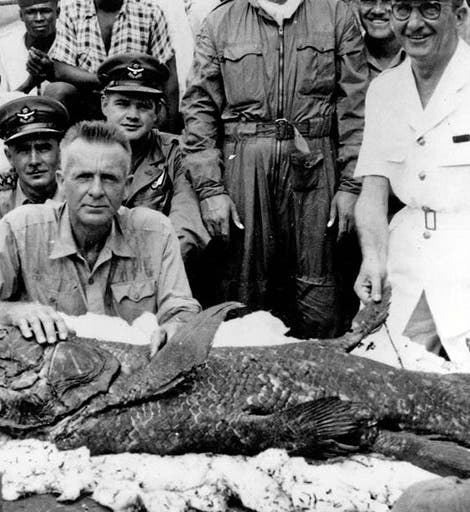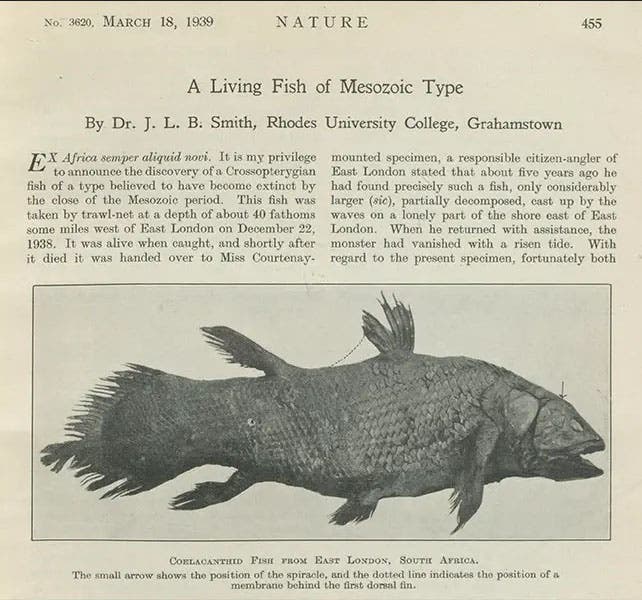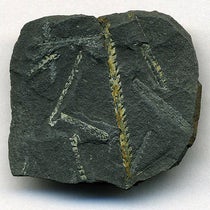Scientist of the Day - J.L.B. Smith
James Leonard Brierley Smith, a South African ichthyologist usually referred to as J. L.B. Smith, was born Sep. 26, 1897. He studied chemistry at several South African universities, received his PhD from Cambridge University in England, and then returned to teach chemistry at Rhodes University in Grahamstown, South Africa. His second wife, Margaret, was an ichthyologist at the same university, and she apparently rekindled in Smith a childhood interest in the subject, for his life from 1938 on was all about fish.
It acquired an additional focus in early January, 1939, when he received a letter from a colleague, Marjorie Courtenay-Latimer, who was curator of a museum in East London, a port city in South Africa. The letter contained a description and a sketch of a curious fish she had acquired from a fisherman, with whom she had a standing request for weird fish. This one was about 5 feet long, with four thick fins and a short, split, tail. It was like no other fish she had ever seen. She tried to call Smith, couldn't locate him, and finally wrote him the letter. The fish was found on Dec. 22, 1938, and when she didn't hear from Smith after 4 days, she had to have the fish stuffed and the organs discarded
When Smith, who had been away on business, got the letter in early January, he was frantic to see the specimen, because he suspected what it might be. When he finally saw the stuffed fish in February in East London, he knew his guess was right – this was a coelacanth, a fish that was thought to occupy the late Cretaceous period, and to have been extinct for 65 million years. Extinct, it clearly was not.
We wrote a post on Marjorie Courtenay-Latimer in 2020, in which we showed her sketch of the first coelacanth and the first page of the paper announcing the recovery of the “living fossil” that Smith published in Nature in March of 1939. We include that image here as well, because it shows a photo of the first coelacanth (second image).
Smith went on the hunt for more coelacanths, hoping to find one that had not beent taxidermized and had intact internal organs. He was not successful, at least not for the next 13 years. It was a big ocean out there. Finally, in 1952, he had thousands of leaflets printed up and distributed all along the east coast of Africa. In it, he offered a reward of 100 pounds for the first two new coelacanths found (third image). The leaflets did the trick. In December, 1952, He got a call from the captain of a fishing boat trawling the Comoro Islands off Madagascar, who indeed had pulled up a second coelacanth from the depths. Smith convinced the South African armed forces to fly him to the Comoros in a helicopter, and he saw the fish on Dec. 29. The occasion was recorded in a photograph (first image). Smith finally had his (almost) live specimen to study.
Smith published professional papers about coelacanth number 2, as well as coelecanths 3-8, which turned up in the next several years. But we thought we would mention here the popular book he published in 1956, The Search Beneath the Sea: The Story of the Coelacanth. It tells the exciting tale of the finding of the first coelacanth, and the subsequent successful searches for more. The photograph used for our first image was used for the frontispiece of the book, and it also was the source of our photo of the coelacanth leaflet (third image).
In our post on Courtenay-Latimer, we showed a block of four postage stamps issued by the Republic of South Africa in 1989, on the fiftieth anniversary of the recovery of the first coelacanth. We show them again here (fifth image), because one stamp shows Smith with Courtenay-Latimer, and another shows the J. L. B. Smith Institute of Ichthyology, which was built in Smith’s honor in 1977 and was presided over by Smith’s widow, Margaret. It is now, I believe, the South African Institute for Aquatic Biodiversity
William B. Ashworth, Jr., Consultant for the History of Science, Linda Hall Library and Associate Professor emeritus, Department of History, University of Missouri-Kansas City. Comments or corrections are welcome; please direct to ashworthw@umkc.edu.











